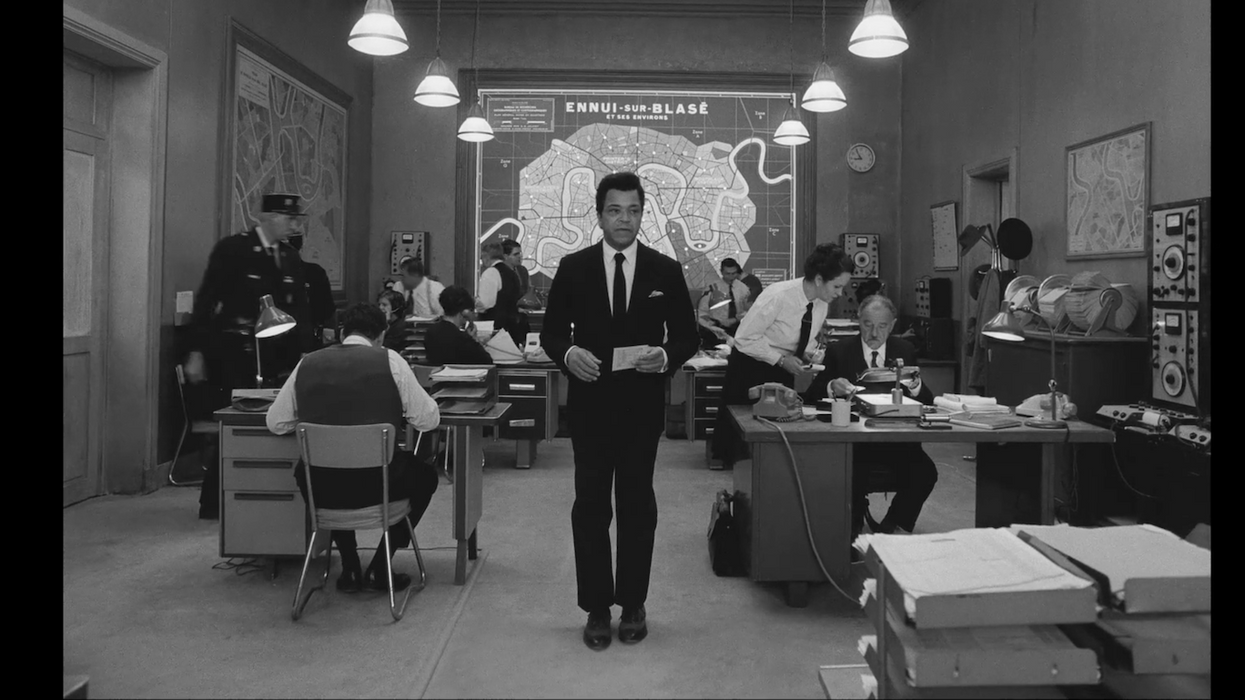Key Grip Sanjay Sami Breaks Down the Impossible 70-Second Take from 'The French Dispatch'
Long takes are hard. Mix that with the ambitious mind of Wes Anderson, and you have yourself one tough obstacle.

You know a Wes Anderson film when you see it. His animation-influenced aesthetic is undeniably unique, bringing precise and zippy camera moves that he was able to master on his miniature sets on his stop-motion productions to his live-action films. The blend of animated camera movement to live-action is becoming increasingly popular, but boy, replicating a practical camera movement in real life can be quite the challenge.
In Anderson’s newest film, The French Dispatch, an anthology of short films about a Sunday supplement to a nonexistent Kansas newspaper, Anderson’s love of complicated camera movements is on full display. The final sequence features a near impossible 70-second tracking shot that the film’s key grip, Sanjay Sami, describes as “the most complicated shot I’ve ever worked on in my life.”
Anderson’s showstopping final sequence follows writer Roebuck Wright (Jeffrey Wright) visiting Ennui-Sur-Blase’s chief of police (Mathieu Almaric) to write a profile of his personal chef, Lieutenant Nescaffier (Stephen Park).
The tracking shot takes the audience through the police station, revealing various rooms like a shooting range and a gymnasium until Roebuck finds himself in solitary confinement where a mobster’s accountant (Willem Dafoe) is being held. During his journey, Roebuck discusses Nescaffier’s cooking.
The shot was difficult to plan, according to Sami, who has been working with Anderson since The Darjeeling Limited. Anderson wanted to put his camera on rails to shoot the scene and have that camera do things that a camera on a track can’t do, like zigzag at high speeds at precisely 90-degree angles at four different points in the shot. The challenge for Sami was creating a shot that Anderson envisioned in his animatics—a tool Anderson has been using to storyboard his scripts into live-action stories since 2010.
The exactness of Anderson’s request mirrors the precision of the language he uses in his screenplays, according to Sami. Every period, comma, colon, semicolon, and dash is meant to elicit a certain emotion or sensation to the mind of the reader.
Sami says, “To me, a stop in a dolly move is a form of punctuation. When you stop the camera, or slow it down and speed it up again, or do whatever, it’s all punctuations.”

The script describes Roebuck exiting an elevator into a “long, institutional-style corridor in a massive 17th-century building” with “dim overhead light[s].”
After describing the scene’s setting, “the camera now follows” Roebuck as he “pokes his head into the doorways of various departmental offices.”
When Sami read this part of the script, he assumed he might have been reading the technical instructions incorrectly. The scene was far too elaborate for a dolly shot that long and extensive.
“I wrote an email to Wes and said, ‘It looks like one shot.’ He said, ‘That’s because it is.’”

With over 100 meters to cover, Sami and Anderson would have to think big while creating the set and camera setup. Anderson decided to build the police station interior set on the production’s principal soundstage in four weeks. The result was a set that covered the entire length of the soundstage. As the choreography was practiced within the space, Sami focused his attention on the camera rig.
Sami used an updated version of his Mangalore rig, a custom-built length of two-tiered dolly tracks that looked like a wooden toy train that moved along a grid system that required a crew member to manually pull a pin at a specific point, turning the end of one piece of track into a dolly platform to carry the camera along on the next length of track. The Mangalore 2.0 would need dollies stacked on top of dollies and pins upon pins to free pieces of track to achieve the three 90-degree turns required to navigate the space.
Wright says, “It’s an act of incredible boldness and confidence, shooting the scene the way Wes shot it. I think it shows Roebuck Wright at the peak of his confidence in the story, reciting from memory… passages from his best-known magazine piece, for a rapt audience. Most delightfully, he turns the police station, a place that tends to be inhospitable to men such as himself, into a set, almost a playground, that Roebuck Wright is completely in control of.”
The tracking shot on the set of 'The French Dispatch'Credit: Roger Do Minh/Searchlight Pictures
Roebuck’s narration as he moved through the space was originally set to be a voiceover, but Wright asked Anderson if he could say the lines while moving through the space, nailing it on the first take.
The boom operator, Damien Luquet, was able to move with Wright as he weaved through the set, dancing backward in and out of the camera range as the camera constantly shifted on the track. It was both a physical and mental exercise for the cast and crew.
While there are times that Anderson’s storybook aesthetics become an obstacle to overcome, the commitment of Anderson and his team to try new and bold camera movements in the world of live-action filmmaking can push the envelope of what is possible through innovation.
“[Y]ou just have to accept that Wes is right,” says Sami. “Even when he’s completely mad, he’s right. Even if you don’t think he was right on the set, when you finally sit down to watch the full cut and you get to one of those scenes, you invariably think. ‘Oh my God—he was right.'”
Is there another sequence from The French Dispatch that blows your mind? Let us know what it is in the comments!
Source: Vulture











